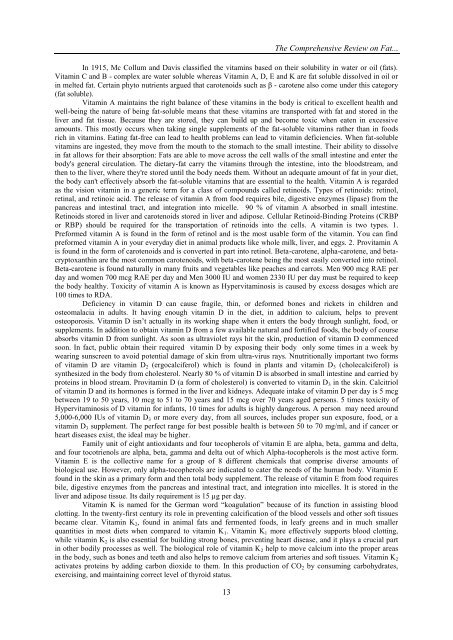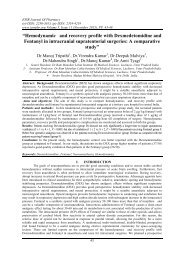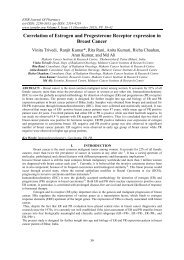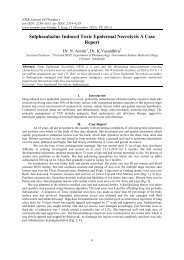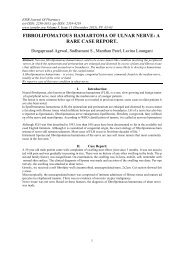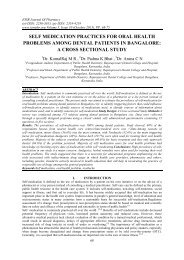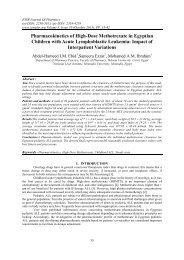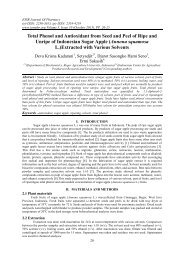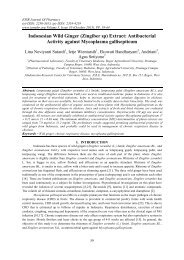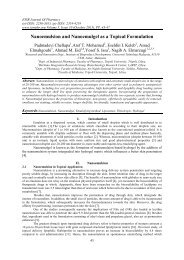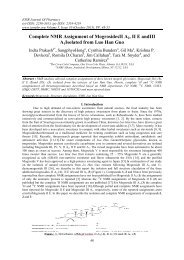The Comprehensive Review on Fat Soluble Vitamins
This review article deals with brief description of fat soluble vitamins with figures and tables showing statistical analytical data duly quoting the references wherever necessary. The word “soluble” actually means “able to be dissolved.” Whether a vitamin is classified as 'fat-soluble' or 'water-soluble' has to do with how the vitamin is absorbed, stored and removed from the body. Vitamins are tiny organic compounds with a huge impact on the health and well-being of the body. The body needs a small amount of fat soluble vitamins in order to stay in optimal health. Fat soluble vitamins play an important role in keeping the body healthy and functioning from immune system and muscle and heart function, easy flow and clotting of blood as well as eye health. They are critical to health and wellness–particularly reproductive health and wellness. Low-fat, no-fat and vegan diets are woefully lacking in fat soluble vitamins. However a diet based on traditional foods can naturally provide these vitamins. Science is still learning about many of the functions of vitamins. "Too much vitamin A, D, or K can lead to increased levels that are unhealthy and can cause serious health consequences. Diseased conditions leading to decreased fat absorption leads to decreased absorption of vitamins. The fatsoluble vitamins work most safely and effectively when obtained them from natural foods within the context of a diet rich in all their synergistic partners. If fat soluble vitamins are stored for lengthy time they generate threat for toxicity than water soluble vitamins and such situation even aggravated, provided they are consumed in excess. Vitamin products, above the legal limits are not considered food supplements and must be registered as prescription or non-prescription (over-the-counter drugs) due to their potential side effects. Vitamin A and E supplements do not provide health benefits for healthy individuals, instead they may enhance mortality, and it is held proved that beta-carotene supplements can be harmful to smokers.
This review article deals with brief description of fat soluble vitamins with figures and tables
showing statistical analytical data duly quoting the references wherever necessary. The word “soluble” actually
means “able to be dissolved.” Whether a vitamin is classified as 'fat-soluble' or 'water-soluble' has to do with
how the vitamin is absorbed, stored and removed from the body. Vitamins are tiny organic compounds with a
huge impact on the health and well-being of the body. The body needs a small amount of fat soluble vitamins in
order to stay in optimal health. Fat soluble vitamins play an important role in keeping the body healthy and
functioning from immune system and muscle and heart function, easy flow and clotting of blood as well as eye
health. They are critical to health and wellness–particularly reproductive health and wellness. Low-fat, no-fat
and vegan diets are woefully lacking in fat soluble vitamins. However a diet based on traditional foods can
naturally provide these vitamins. Science is still learning about many of the functions of vitamins. "Too much
vitamin A, D, or K can lead to increased levels that are unhealthy and can cause serious health consequences.
Diseased conditions leading to decreased fat absorption leads to decreased absorption of vitamins. The fatsoluble
vitamins work most safely and effectively when obtained them from natural foods within the context of a
diet rich in all their synergistic partners. If fat soluble vitamins are stored for lengthy time they generate threat
for toxicity than water soluble vitamins and such situation even aggravated, provided they are consumed in
excess. Vitamin products, above the legal limits are not considered food supplements and must be registered as
prescription or non-prescription (over-the-counter drugs) due to their potential side effects. Vitamin A and E
supplements do not provide health benefits for healthy individuals, instead they may enhance mortality, and it is
held proved that beta-carotene supplements can be harmful to smokers.
You also want an ePaper? Increase the reach of your titles
YUMPU automatically turns print PDFs into web optimized ePapers that Google loves.
13<br />
<str<strong>on</strong>g>The</str<strong>on</strong>g> <str<strong>on</strong>g>Comprehensive</str<strong>on</strong>g> <str<strong>on</strong>g>Review</str<strong>on</strong>g> <strong>on</strong> <strong>Fat</strong>...<br />
In 1915, Mc Collum and Davis classified the vitamins based <strong>on</strong> their solubility in water or oil (fats).<br />
Vitamin C and B - complex are water soluble whereas Vitamin A, D, E and K are fat soluble dissolved in oil or<br />
in melted fat. Certain phyto nutrients argued that carotenoids such as β - carotene also come under this category<br />
(fat soluble).<br />
Vitamin A maintains the right balance of these vitamins in the body is critical to excellent health and<br />
well-being the nature of being fat-soluble means that these vitamins are transported with fat and stored in the<br />
liver and fat tissue. Because they are stored, they can build up and become toxic when eaten in excessive<br />
amounts. This mostly occurs when taking single supplements of the fat-soluble vitamins rather than in foods<br />
rich in vitamins. Eating fat-free can lead to health problems can lead to vitamin deficiencies. When fat-soluble<br />
vitamins are ingested, they move from the mouth to the stomach to the small intestine. <str<strong>on</strong>g>The</str<strong>on</strong>g>ir ability to dissolve<br />
in fat allows for their absorpti<strong>on</strong>: <strong>Fat</strong>s are able to move across the cell walls of the small intestine and enter the<br />
body's general circulati<strong>on</strong>. <str<strong>on</strong>g>The</str<strong>on</strong>g> dietary-fat carry the vitamins through the intestine, into the bloodstream, and<br />
then to the liver, where they're stored until the body needs them. Without an adequate amount of fat in your diet,<br />
the body can't effectively absorb the fat-soluble vitamins that are essential to the health. Vitamin A is regarded<br />
as the visi<strong>on</strong> vitamin in a generic term for a class of compounds called retinoids. Types of retinoids: retinol,<br />
retinal, and retinoic acid. <str<strong>on</strong>g>The</str<strong>on</strong>g> release of vitamin A from food requires bile, digestive enzymes (lipase) from the<br />
pancreas and intestinal tract, and integrati<strong>on</strong> into micelle. 90 % of vitamin A absorbed in small intestine.<br />
Retinoids stored in liver and carotenoids stored in liver and adipose. Cellular Retinoid-Binding Proteins (CRBP<br />
or RBP) should be required for the transportati<strong>on</strong> of retinoids into the cells. A vitamin is two types. 1.<br />
Preformed vitamin A is found in the form of retinol and is the most usable form of the vitamin. You can find<br />
preformed vitamin A in your everyday diet in animal products like whole milk, liver, and eggs. 2. Provitamin A<br />
is found in the form of carotenoids and is c<strong>on</strong>verted in part into retinol. Beta-carotene, alpha-carotene, and betacryptoxanthin<br />
are the most comm<strong>on</strong> carotenoids, with beta-carotene being the most easily c<strong>on</strong>verted into retinol.<br />
Beta-carotene is found naturally in many fruits and vegetables like peaches and carrots. Men 900 mcg RAE per<br />
day and women 700 mcg RAE per day and Men 3000 IU and women 2330 IU per day must be required to keep<br />
the body healthy. Toxicity of vitamin A is known as Hypervitaminosis is caused by excess dosages which are<br />
100 times to RDA.<br />
Deficiency in vitamin D can cause fragile, thin, or deformed b<strong>on</strong>es and rickets in children and<br />
osteomalacia in adults. It having enough vitamin D in the diet, in additi<strong>on</strong> to calcium, helps to prevent<br />
osteoporosis. Vitamin D isn’t actually in its working shape when it enters the body through sunlight, food, or<br />
supplements. In additi<strong>on</strong> to obtain vitamin D from a few available natural and fortified foods, the body of course<br />
absorbs vitamin D from sunlight. As so<strong>on</strong> as ultraviolet rays hit the skin, producti<strong>on</strong> of vitamin D commenced<br />
so<strong>on</strong>. In fact, public obtain their required vitamin D by exposing their body <strong>on</strong>ly some times in a week by<br />
wearing sunscreen to avoid potential damage of skin from ultra-virus rays. Nnutriti<strong>on</strong>ally important two forms<br />
of vitamin D are vitamin D 2 (ergocalciferol) which is found in plants and vitamin D 3 (cholecalciferol) is<br />
synthesized in the body from cholesterol. Nearly 80 % of vitamin D is absorbed in small intestine and carried by<br />
proteins in blood stream. Provitamin D (a form of cholesterol) is c<strong>on</strong>verted to vitamin D 3 in the skin. Calcitriol<br />
of vitamin D and its horm<strong>on</strong>es is formed in the liver and kidneys. Adequate intake of vitamin D per day is 5 mcg<br />
between 19 to 50 years, 10 mcg to 51 to 70 years and 15 mcg over 70 years aged pers<strong>on</strong>s. 5 times toxicity of<br />
Hypervitaminosis of D vitamin for infants, 10 times for adults is highly dangerous. A pers<strong>on</strong> may need around<br />
5,000-6,000 IUs of vitamin D 3 or more every day, from all sources, includes proper sun exposure, food, or a<br />
vitamin D 3 supplement. <str<strong>on</strong>g>The</str<strong>on</strong>g> perfect range for best possible health is between 50 to 70 mg/ml, and if cancer or<br />
heart diseases exist, the ideal may be higher.<br />
Family unit of eight antioxidants and four tocopherols of vitamin E are alpha, beta, gamma and delta,<br />
and four tocotrienols are alpha, beta, gamma and delta out of which Alpha-tocopherols is the most active form.<br />
Vitamin E is the collective name for a group of 8 different chemicals that comprise diverse amounts of<br />
biological use. However, <strong>on</strong>ly alpha-tocopherols are indicated to cater the needs of the human body. Vitamin E<br />
found in the skin as a primary form and then total body supplement. <str<strong>on</strong>g>The</str<strong>on</strong>g> release of vitamin E from food requires<br />
bile, digestive enzymes from the pancreas and intestinal tract, and integrati<strong>on</strong> into micelles. It is stored in the<br />
liver and adipose tissue. Its daily requirement is 15 µg per day.<br />
Vitamin K is named for the German word “koagulati<strong>on</strong>” because of its functi<strong>on</strong> in assisting blood<br />
clotting. In the twenty-first century its role in preventing calcificati<strong>on</strong> of the blood vessels and other soft tissues<br />
became clear. Vitamin K 2 , found in animal fats and fermented foods, in leafy greens and in much smaller<br />
quantities in most diets when compared to vitamin K 1 . Vitamin K 1 more effectively supports blood clotting,<br />
while vitamin K 2 is also essential for building str<strong>on</strong>g b<strong>on</strong>es, preventing heart disease, and it plays a crucial part<br />
in other bodily processes as well. <str<strong>on</strong>g>The</str<strong>on</strong>g> biological role of vitamin K 2 help to move calcium into the proper areas<br />
in the body, such as b<strong>on</strong>es and teeth and also helps to remove calcium from arteries and soft tissues. Vitamin K 2<br />
activates proteins by adding carb<strong>on</strong> dioxide to them. In this producti<strong>on</strong> of CO 2 by c<strong>on</strong>suming carbohydrates,<br />
exercising, and maintaining correct level of thyroid status.


